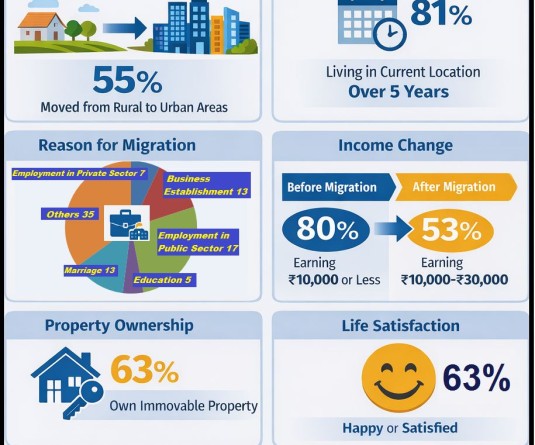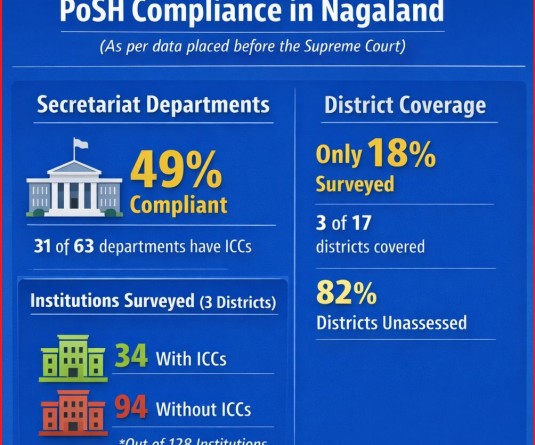The table showing the percentage of children enrolled in different types of school in Nagaland by age, sex, and other related parameters in 2024 as per the Annual Status of Education Report (ASER) 2024. The chart shows trends over time of the percentage of children not enrolled in school from 2006-2024 as per the report. (Image based on ASER 2024 State-wise data)

Morung Express News
Dimapur | January 28
The Annual Status of Education Report (ASER) 2024, which was released this morning in New Delhi, highlighted both progress and persistent challenges in the education sector across rural Nagaland. The survey, which is the 14th nationwide field-based survey, facilitated by Pratham, was conducted in 329 villages from 11 districts (2011 census) of the state, assessed the educational status of 10,056 children aged 3-16 and gathered data from 5,652 households.
The survey revealed that the state is making strides in early childhood education, with high enrollment rates for children aged 3, 4 and 5. The enrollment in preschool programs for children aged 5 in rural Nagaland was close to universal, with only 1.9% of children aged 5 not enrolled in any form of early education.
This is significantly better than the national average of 6.2%. Preschool coverage, which includes Anganwadis, pre-primary school classes, and private institutions, shows that preschool enrollment for children aged 3 and 4 has steadily increased over the past six years.
Specifically, 62.2% of children aged 3 are enrolled in some form of preschool in 2024, up from 53.1% in 2022. For children aged 4, enrollment in preschool stands at 89.0%, a slight dip from 90.0% in 2022. For children aged 5, enrollment in preschool stands at 91%, a slight up from 90.5% in 2022.
Regarding school enrollment for children aged 6-14; Nagaland continues to show near-universal enrollment rates, reaching 98.6% in 2024.
Private school enrollment has increased significantly, with more than half of children in this age group now enrolled in private schools. However, while enrollment numbers are high, learning outcomes remain inconsistent. In particular, the learning recovery for foundational arithmetic in Standard III has been more promising than for reading.
In terms of school attendance, ASER data highlighted a decrease in attendance levels in rural Nagaland. Primary school student attendance dropped from 85.2% in 2022 to 80.7% in 2024. Teacher attendance also declined from 89.8% to 83.7%, though it remains higher than the national average.
In Standard III, the arithmetic skills of children showed a notable improvement since 2022, with a 3.7% increase in the ability to perform subtraction. However, reading levels for this age group declined, especially among children in private schools.
In Standard V, reading levels remained stagnant compared to 2018, and while arithmetic skills showed signs of recovery from the losses due to the pandemic, the reading levels in 2024 were lower than those in 2022.
School infrastructure has shown consistent improvement, with better availability of facilities such as mid-day meals, drinking water, usable toilets, and electricity. However, the percentage of schools with usable girls' toilets has decreased slightly.
Schools also reported receiving increased support for foundational literacy and numeracy (FLN) activities, with 92.2% of schools in 2024 receiving directives from the government to implement FLN activities for early grades, reflecting the ongoing focus on strengthening primary education.
Key findings for Nagaland
Enrollment Trends: Enrollment in early childhood education is rising, with preschool enrollment rates for children aged 4 and 5 surpassing 90%.
School Enrollment for Age 6-14: Nagaland shows nearly universal enrollment, with a continued rise in private school enrollment.
Learning Levels: Arithmetic levels have improved in Standard III, but reading levels have declined. Standard V reading levels remain stagnant.
Out-of-School Figures: There is a significant gender gap in school enrollment for older children, with more boys aged 15-16 out of school compared to girls.
Digital Skills: Most 14-16-year-olds have access to smartphones and can perform basic digital tasks with relative ease.
School Facilities: School facilities such as mid-day meals, drinking water, toilets, and electricity have seen improvement, though girls’ toilets have seen a slight decrease in usability.






